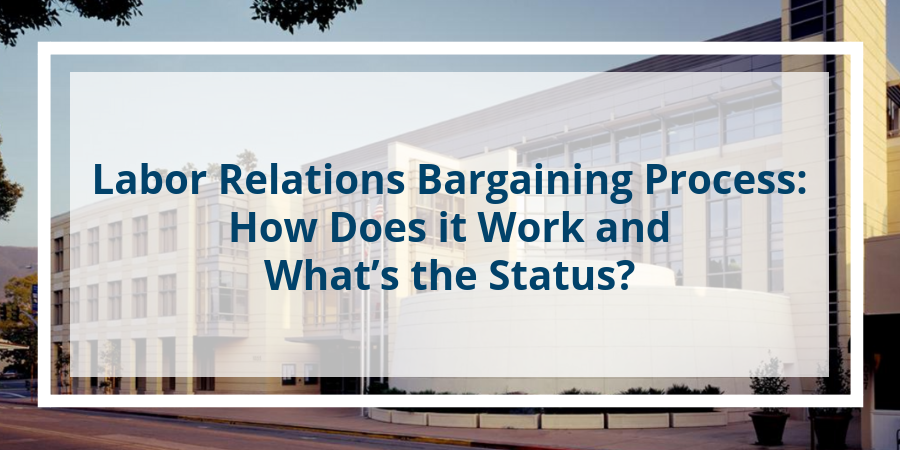
Labor Relations Bargaining Process
Author: Human Resources
Date: 3/26/2019 4:22 PM
How does the Labor Relations Bargaining Process Work and What's the Status?
In response to employee feedback, we understand some of you might be wondering what’s happening at the County labor relations bargaining table and how the process works.
Here’s an update on SLOCEA negotiations: Since the start of 2019, the County has held several employee listening sessions, employees have met with the Board of Supervisors, and the bargaining team has been preparing for upcoming bargaining sessions. In January, we agreed with SLOCEA to start negotiations in early spring. After the County and SLOCEA considered dates, parties agreed to commence negotiations on April 8 for Trades Unit (BU 02) and April 9 for “Big Unit” (BU 01, 05, 13). In the coming months, we will provide updates related to the bargaining process.
We realize that not all employees have served on a union negotiating team or been closely involved with the process. Before understanding the bargaining process, it’s important to recognize the framework of labor unions and contract negotiations.
The 4 Key Points for the Contract Negotiations Framework
- Employee Organizations and Bargaining Units: For many decades, County employee organizations have served as the “exclusive representatives” of the employees they represent. Representation is by bargaining unit, with each union representing a different facet of the workforce. By far the largest employee organization is SLOCEA, which represents a total of four bargaining units that include over half of the County’s total workforce. Other bargaining units exist for a diverse group of professions, including law enforcement, attorneys, and probation officers among others.
- Scope of Representation and Memoranda of Understanding: The purpose of bargaining is to address issues of concern to employee organizations and the County, relating to all matters that are within the “scope of representation.” This technical term refers to wages, hours, working conditions and all matters relating to those issues, except for core management interests (“management rights”) such as determining the work to be performed and services provided. The results of collective bargaining, when successful, are incorporated into and amend the comprehensive “Memorandum of Understanding” (MOU), which is an agreement between two or more parties outlining the terms and details of an understanding, that the County has with the affected employee organization.
- Good Faith Is Essential: By law, a key tenet to bargaining is the mutual obligation to negotiate in “good faith.” This means that both parties must have a good faith intent to reach agreement, and act accordingly. This includes meeting in person; continuing for a reasonable time in order to exchange information, opinions and proposals; and being open to compromise when possible. This obligation extends throughout the bargaining process, including during any impasse procedures.
- Tone and Commitment to Relationship: In the world outside of San Luis Obispo County, collective bargaining is often viewed as an adversarial process. But the degree of cooperation between management and any employee organization depends on the perspective of the leaders of the employee organization, and on the difficulties that the negotiations involve. County representatives try hard to focus on solving problems through negotiations and believe strongly in labor/management cooperation. In the County’s experience, County employee organizations are similarly inclined. If there is a serious dispute in negotiations leading either party to believe their counterpart is negotiating in bad faith, the aggrieved party can initiate charges of “unfair labor practice” with PERB.
Breakdowns can occur in negotiations and lead to strife, including “concerted activity” by employee organizations, which are protected by the National Labor Relations Act. But it is often stated that, unlike other areas of life, there is no “divorce” in labor relations: The relationship between an employee organization and employer is almost always permanent. This is an important reason why the parties typically work hard to repair their relationship after any breakdown.
The Bargaining Process in 7 Steps
Bargaining is an intricate, multi-step process that typically takes months. Here are the basic steps to the bargaining process:
- Representatives and bargaining teams are identified. The parties in negotiations include the members of the bargaining unit and the representatives of the Board of Supervisors. In our County, the Management Representative for the Board of Supervisors is the Human Resources Director. The Board of Supervisors provides policy direction to its negotiators. Each side appoints the members of its bargaining team, including their chief negotiator.
- Preparations begin. The bargaining teams prepare separately for negotiations by reviewing the MOU, workplace problems and past practices, by meeting with their stakeholders to assess needs and priorities and gathering data. Because wages and benefits are always a key issue in negotiations, each party gathers data about economics (wage and benefits surveys, assessment of the County’s financial condition, etc.). Each party has duty to provide requested information relevant to negotiations, such as information about the County’s financial condition.
- Negotiations begin. The parties commence meeting well in advance of the expiration of their MOU and/or before the beginning of the next fiscal year. The parties start negotiations by discussing ground rules that govern negotiations (such as protocols relating to exchange of information and proposals and released time for the employee organization’s team members). The parties exchange and introduce their opening proposals, and over a series of meetings, the parties discuss their respective proposals and explore possible compromises. The proposals typically address many of the sections of the MOU (e.g., wages, health benefits, hours, etc.)
- The bargaining teams reach a tentative agreement or reach an impasse. As the parties reach agreement to proposals, they may sign off with a “tentative agreement” (“TA”). TAs are not legally binding and are subject to agreement on the entire MOU. Through this process, the parties can often reach overall agreement on a successor MOU. Such an agreement is subject to ratification by the members of the employee organization, and then to adoption by the Board of Supervisors. The MOU does not become binding until/unless it is both ratified and adopted.Once adopted, the terms of the new MOU are in effect.
If the parties do not reach overall agreement, one party or both may declare an “impasse” in bargaining, signifying a deadlock on key issues. If an impasse occurs, the parties can (but are not required to) agree to mediate the dispute by bringing in a professional labor mediation – typically a mediator from the State Mediation and Conciliation Service. - Unions may invoke the fact-finding process. The employee organization also has a right to invoke “fact finding” within the timelines defined by law. Factfinding is a hearing process in which a neutral factfinder (typically a labor arbitrator) and a representative of each party receive evidence from each party about their position on the dispute. The factfinding panel makes a decision that finds the facts underlying the dispute and recommends terms of settlement. Often, the panel is not unanimous. The party that does not prevail on a given issue can file a dissent. The factfinding decision issued by the neutral factfinder is non-binding to either party. The decision is to be made public within 10 days of issuance.
- Post-factfinding bargaining begins. The parties engage in post-factfinding bargaining to see if the factfinding panel decision could lead toward compromise.
- The parties either come to an agreement or not. If factfinding does not lead to agreement, the negotiations process is deemed complete. At that point, the County may (but is not required to) implement its final offer, and the employee organization has a right to strike, with certain exceptions including a prohibition on health and safety strikes.
The County is committed to labor/management cooperation and to making the County a great place to work. We are committed to doing our best to maintain good relationships with employee organizations and to demonstrating our good faith in all dealings with County employee organizations and County personnel. We hope you found this article insightful!
